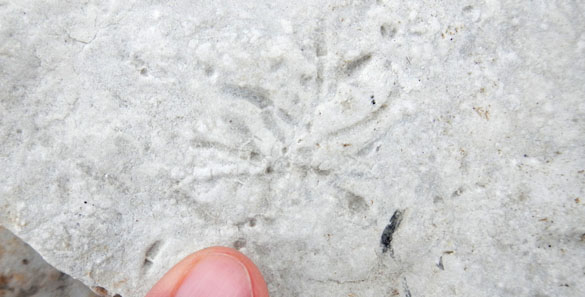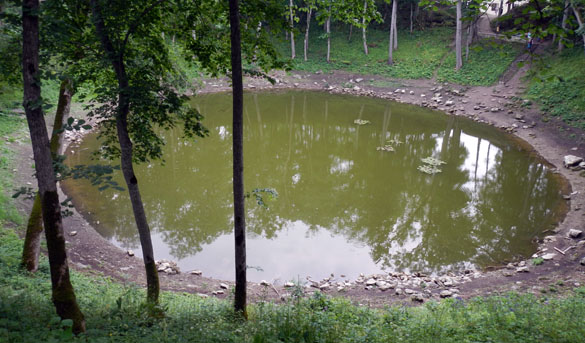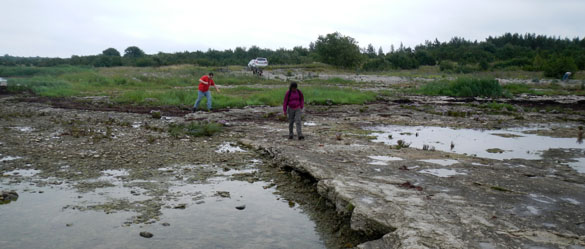 KÄINA, ESTONIA–Today Jonah Novek officially began the fieldwork for his Independent Study research: a sedimentological and faunal analysis of the Hilliste Formation (Lower Silurian, Rhuddanian) on Hiiumaa Island, Estonia. Jonah will be continuing the work begun by Rachel Matt (’12) last year in the Hilliste Quarry a few kilometers east of Käina (N 58.87390°, E 022.97198°). He has already today been ably assisted by the generous Ohio State University crew and Richa who gave him numerous fossils they collected from the limestones and shales. Jonah and Richa completed the stratigraphic column today (essentially measurements and descriptions of the rock units, from bottom to top) and began to collect fossils from each unit. We will return at least one more day this week for continued collection.
KÄINA, ESTONIA–Today Jonah Novek officially began the fieldwork for his Independent Study research: a sedimentological and faunal analysis of the Hilliste Formation (Lower Silurian, Rhuddanian) on Hiiumaa Island, Estonia. Jonah will be continuing the work begun by Rachel Matt (’12) last year in the Hilliste Quarry a few kilometers east of Käina (N 58.87390°, E 022.97198°). He has already today been ably assisted by the generous Ohio State University crew and Richa who gave him numerous fossils they collected from the limestones and shales. Jonah and Richa completed the stratigraphic column today (essentially measurements and descriptions of the rock units, from bottom to top) and began to collect fossils from each unit. We will return at least one more day this week for continued collection.
 The Hilliste Formation is very important in evolutionary and ecological studies because it records an Early Silurian “recovery fauna” that lived after the massive end-Ordovician extinctions. There are very few other shelly faunas of this age in the northern hemisphere. This may be the only one that has survived from the ancient paleocontinent of Baltica. The preservation of the fossils is excellent. Above is a heliolitid coral from the unit we have designated “Hi-2”.
The Hilliste Formation is very important in evolutionary and ecological studies because it records an Early Silurian “recovery fauna” that lived after the massive end-Ordovician extinctions. There are very few other shelly faunas of this age in the northern hemisphere. This may be the only one that has survived from the ancient paleocontinent of Baltica. The preservation of the fossils is excellent. Above is a heliolitid coral from the unit we have designated “Hi-2”.
 Bill Ausich of Ohio State (pictured above in a heroic pose that we call “the Walcott“) found what I think is the most interesting fossil of the day in the Hilliste Quarry. His goal has been to discover as many crinoid calices as possible in the Silurian of the western Estonian islands. Finding such treasures in the Hilliste Quarry started a bit slowly, but he collected this fascinating specimen:
Bill Ausich of Ohio State (pictured above in a heroic pose that we call “the Walcott“) found what I think is the most interesting fossil of the day in the Hilliste Quarry. His goal has been to discover as many crinoid calices as possible in the Silurian of the western Estonian islands. Finding such treasures in the Hilliste Quarry started a bit slowly, but he collected this fascinating specimen:
 It is a favositid coral surface with two crinoid holdfasts attached. These holdfasts are essentially single roots with little rootlets that gripped the corallites of the coral. There is no more persuasive indicator that crinoids lived with corals here! I had not seen holdfasts like these before, which shows again the value of working with colleagues in the field.
It is a favositid coral surface with two crinoid holdfasts attached. These holdfasts are essentially single roots with little rootlets that gripped the corallites of the coral. There is no more persuasive indicator that crinoids lived with corals here! I had not seen holdfasts like these before, which shows again the value of working with colleagues in the field.
 There are also inorganic mysteries in the Hilliste Quarry. Above is an image of a bedding plane near the base of our section (unit Hi-1) that displays ripple marks in a micritic (fine-grained) limestone matrix. The compass shows the north direction, as does the measuring stick. We don’t know how ripples are formed in such a fine sediment (the particles would have been near clay size), nor what environmental forces they indicate. We do know that some show interference patterns (possibly from wave currents) and that they show similar directional orientations.
There are also inorganic mysteries in the Hilliste Quarry. Above is an image of a bedding plane near the base of our section (unit Hi-1) that displays ripple marks in a micritic (fine-grained) limestone matrix. The compass shows the north direction, as does the measuring stick. We don’t know how ripples are formed in such a fine sediment (the particles would have been near clay size), nor what environmental forces they indicate. We do know that some show interference patterns (possibly from wave currents) and that they show similar directional orientations.
 The only place in the quarry that exposes our lowest unit, by the way, has this wasp’s nest hanging over it. The wasps understandably are quite irritated by hammer blows on the rocks around them, so we must be watchful at this spot!
The only place in the quarry that exposes our lowest unit, by the way, has this wasp’s nest hanging over it. The wasps understandably are quite irritated by hammer blows on the rocks around them, so we must be watchful at this spot!
Good luck to Jonah as he begins his capstone college intellectual adventure. We’ll have more about this project later this week!










































 Monticello
Monticello
